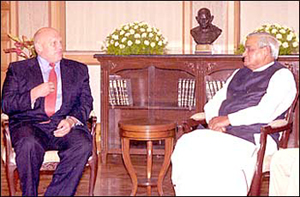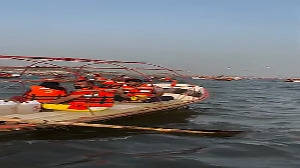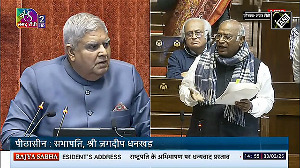Despite its denials, Washington does seem to have a very specific roadmap for facilitating peace in the Indian subcontinent.
In the first part of a series based on official documents prepared by the American mission in Islamabad, we examine the implications of specific American proposals which ambitiously envisage, among other things, free civilian traffic across the Line of Control by 2005.
 When Deputy Secretary of State Richard Armitage repeatedly denied during his visit to the subcontinent last week that America has a roadmap to resolve the problem of Jammu and Kashmir, which has been festering for more than half a century, he was probably being economical with the truth.
When Deputy Secretary of State Richard Armitage repeatedly denied during his visit to the subcontinent last week that America has a roadmap to resolve the problem of Jammu and Kashmir, which has been festering for more than half a century, he was probably being economical with the truth.
rediff.com has in its possession documents on American plans for Pakistan, which also contain elaborate details of their roadmap for Jammu and Kashmir and the rest of the subcontinent.
Outlining America's socio-political and economic targets in Pakistan, these documents are a stunning narrative of the intense involvement of the United States in almost every aspect of Pakistan's life, and provides a background to the well-choreographed American shuttle missions in the region far from US shores.
They also spell out a detailed American strategy, with specific annual targets, to resolve the Kashmir standoff in a phased manner.
The US strategy proposes three basic steps:
- Press Pakistan to prevent the infiltration of terrorists across the Line of Control.
- Urge Pakistan to move against terrorists and help it bring them to justice by improving its law-enforcement capabilities.
- Facilitate an Indo-Pakistan dialogue on Kashmir.
For 2003, America plans to get India and Pakistan to revive bilateral talks.
In 2004, both India and Pakistan are to agree to jointly monitor the Line of Control, while 'political leaders from both sides of the Line of Control in Kashmir [start a] dialogue'.
In 2005, civilian traffic should begin moving regularly across the LoC. Of course, long before that militancy in the state is expected to be quelled.
Though the documents do not formally advocate the partition of Jammu and Kashmir and the conversion of the LoC into an international border between India and Pakistan, they do hint at it. In fact, at no point in the papers is there a discussion about changing the existing Line of Control or any of the rest of the border between India and Pakistan.
Significantly, the Central Intelligence Agency released a map of the subcontinent this year which for the first time portrayed Jammu and Kashmir as a part of India.
As for terrorism, the documents say that by later this year Pakistan should begin 'successful prosecutions of sectarian, religious extremists and Kashmiri militant leaders' and by 2004 America will get Pakistan to stop 'Kashmiri militant groups and supporters from openly raising money'.
Indeed, if the present direction of Indo-Pakistan relations is anything to go by, the bilateral dialogue will resume by this yearend. And, if the two sides make headway, Kashmiri political leaders should be able to join consultations with them next year.
In 2005, when civilian traffic is flowing freely across the 740km LoC, Kashmiri political leaders are expected to 'assume prominence in national Kashmir political discourse' and a 'framework for eventual political resolution of Kashmir' is likely to be put in place, according to the documents.
The detailed Kashmir plan was laid out with the US financial year 2001 as the base year, when terrorist groups were enjoying 'strong Pakistani support' though there were 'partial crackdowns against some Kashmiri militant groups and leaders'.
In 2002, the US wanted to end 'cross-border militancy' while giving the provincial and national police authorities of Pakistan 'mandate, training, equipment to arrest extremists'.
During his visit to the subcontinent in June 2002, Deputy Secretary Armitage managed to get a pledge from Pakistan's military ruler General Pervez Musharraf that 'cross-border terrorism' would be halted. But that promise was observed more in the breach.
But as envisaged, the Americans provided training and equipment to the Pakistani police forces and, in fact, got Gen Musharraf to designate the Federal Investigating Agency as the nodal agency in the fight against terrorism.
The US also provided an additional package worth $73 million in 2002 to improve security along the border with Afghanistan. This money was primarily used for 'equipment, training and operational support, including helicopters and surveillance and communication equipment'. And through the justice department, the Americans also deputed two police officers to co-ordinate all these efforts.
In 2003, one of the American targets is to replace Kashmiri terrorist leaders and extremists by 'Kashmiri politicians'. This is clear in the way the US has ignored leaders of the All-Parties Hurriyat Conference and other fringe elements in recent days, after its appeal to them to take part in the Jammu and Kashmir assembly election last year proved futile.
America also proposes to nudge the Pakistani authorities to prosecute 'sectarian, religious extremists and Kashmir militant leaders' this year.
Part II: Diplomacy, not force
Part III: The Future of Pakistan's Democracy
Part IV: Policing Pakistani proliferation
Part V: US arms, dollars for Pak loyalty






 © 2025
© 2025